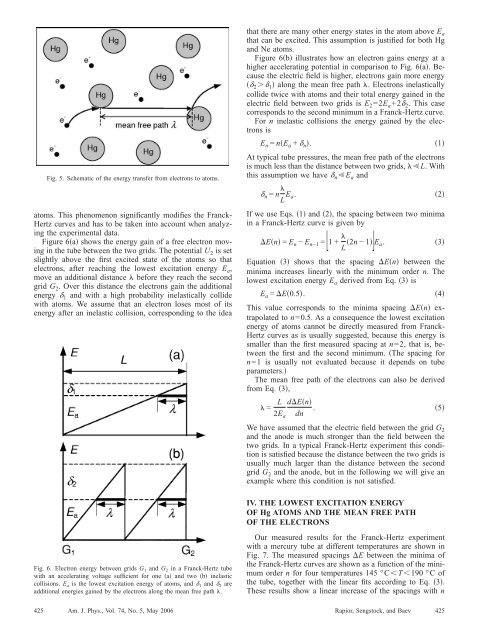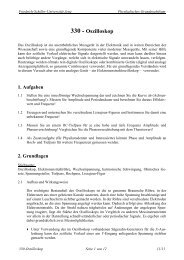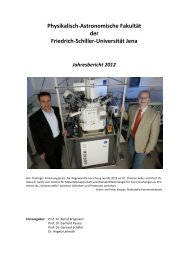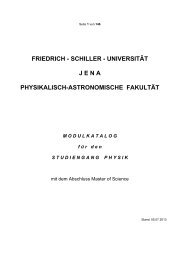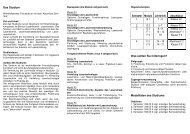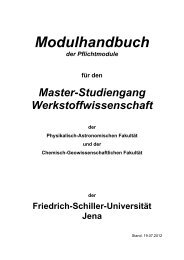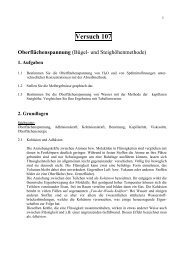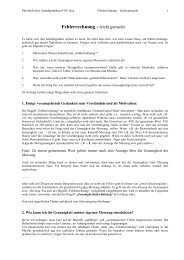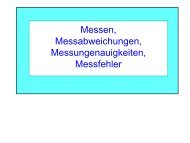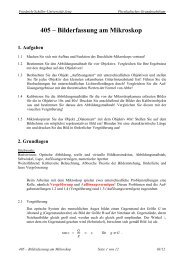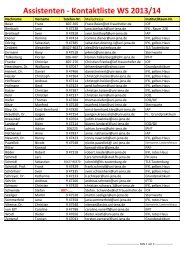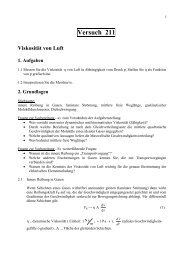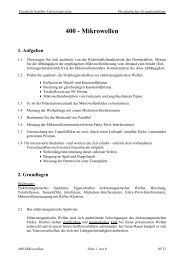New features of the Franck-Hertz experiment - Grundpraktikum Physik
New features of the Franck-Hertz experiment - Grundpraktikum Physik
New features of the Franck-Hertz experiment - Grundpraktikum Physik
Create successful ePaper yourself
Turn your PDF publications into a flip-book with our unique Google optimized e-Paper software.
Fig. 5. Schematic <strong>of</strong> <strong>the</strong> energy transfer from electrons to atoms.<br />
that <strong>the</strong>re are many o<strong>the</strong>r energy states in <strong>the</strong> atom above E a<br />
that can be excited. This assumption is justified for both Hg<br />
and Ne atoms.<br />
Figure 6b illustrates how an electron gains energy at a<br />
higher accelerating potential in comparison to Fig. 6a. Because<br />
<strong>the</strong> electric field is higher, electrons gain more energy<br />
2 1 along <strong>the</strong> mean free path . Electrons inelastically<br />
collide twice with atoms and <strong>the</strong>ir total energy gained in <strong>the</strong><br />
electric field between two grids is E 2 =2E a +2 2 . This case<br />
corresponds to <strong>the</strong> second minimum in a <strong>Franck</strong>-<strong>Hertz</strong> curve.<br />
For n inelastic collisions <strong>the</strong> energy gained by <strong>the</strong> electrons<br />
is<br />
E n = nE a + n .<br />
1<br />
At typical tube pressures, <strong>the</strong> mean free path <strong>of</strong> <strong>the</strong> electrons<br />
is much less than <strong>the</strong> distance between two grids, L. With<br />
this assumption we have n E a and<br />
n = n L E a.<br />
2<br />
atoms. This phenomenon significantly modifies <strong>the</strong> <strong>Franck</strong>-<br />
<strong>Hertz</strong> curves and has to be taken into account when analyzing<br />
<strong>the</strong> <strong>experiment</strong>al data.<br />
Figure 6a shows <strong>the</strong> energy gain <strong>of</strong> a free electron moving<br />
in <strong>the</strong> tube between <strong>the</strong> two grids. The potential U 2 is set<br />
slightly above <strong>the</strong> first excited state <strong>of</strong> <strong>the</strong> atoms so that<br />
electrons, after reaching <strong>the</strong> lowest excitation energy E a ,<br />
move an additional distance before <strong>the</strong>y reach <strong>the</strong> second<br />
grid G 2 . Over this distance <strong>the</strong> electrons gain <strong>the</strong> additional<br />
energy 1 and with a high probability inelastically collide<br />
with atoms. We assume that an electron loses most <strong>of</strong> its<br />
energy after an inelastic collision, corresponding to <strong>the</strong> idea<br />
If we use Eqs. 1 and 2, <strong>the</strong> spacing between two minima<br />
in a <strong>Franck</strong>-<strong>Hertz</strong> curve is given by<br />
En = E n − E n−1 =<br />
⌊ 1+ L 2n −1 ⌋ E a.<br />
Equation 3 shows that <strong>the</strong> spacing En between <strong>the</strong><br />
minima increases linearly with <strong>the</strong> minimum order n. The<br />
lowest excitation energy E a derived from Eq. 3 is<br />
E a = E0.5.<br />
4<br />
This value corresponds to <strong>the</strong> minima spacing En extrapolated<br />
to n=0.5. As a consequence <strong>the</strong> lowest excitation<br />
energy <strong>of</strong> atoms cannot be directly measured from <strong>Franck</strong>-<br />
<strong>Hertz</strong> curves as is usually suggested, because this energy is<br />
smaller than <strong>the</strong> first measured spacing at n=2, that is, between<br />
<strong>the</strong> first and <strong>the</strong> second minimum. The spacing for<br />
n=1 is usually not evaluated because it depends on tube<br />
parameters.<br />
The mean free path <strong>of</strong> <strong>the</strong> electrons can also be derived<br />
from Eq. 3,<br />
=<br />
L dEn<br />
. 5<br />
2E a dn<br />
3<br />
We have assumed that <strong>the</strong> electric field between <strong>the</strong> grid G 2<br />
and <strong>the</strong> anode is much stronger than <strong>the</strong> field between <strong>the</strong><br />
two grids. In a typical <strong>Franck</strong>-<strong>Hertz</strong> <strong>experiment</strong> this condition<br />
is satisfied because <strong>the</strong> distance between <strong>the</strong> two grids is<br />
usually much larger than <strong>the</strong> distance between <strong>the</strong> second<br />
grid G 2 and <strong>the</strong> anode, but in <strong>the</strong> following we will give an<br />
example where this condition is not satisfied.<br />
IV. THE LOWEST EXCITATION ENERGY<br />
OF Hg ATOMS AND THE MEAN FREE PATH<br />
OF THE ELECTRONS<br />
Fig. 6. Electron energy between grids G 1 and G 2 in a <strong>Franck</strong>-<strong>Hertz</strong> tube<br />
with an accelerating voltage sufficient for one a and two b inelastic<br />
collisions. E a is <strong>the</strong> lowest excitation energy <strong>of</strong> atoms, and 1 and 2 are<br />
additional energies gained by <strong>the</strong> electrons along <strong>the</strong> mean free path .<br />
Our measured results for <strong>the</strong> <strong>Franck</strong>-<strong>Hertz</strong> <strong>experiment</strong><br />
with a mercury tube at different temperatures are shown in<br />
Fig. 7. The measured spacings E between <strong>the</strong> minima <strong>of</strong><br />
<strong>the</strong> <strong>Franck</strong>-<strong>Hertz</strong> curves are shown as a function <strong>of</strong> <strong>the</strong> minimum<br />
order n for four temperatures 145 °CT190 °C <strong>of</strong><br />
<strong>the</strong> tube, toge<strong>the</strong>r with <strong>the</strong> linear fits according to Eq. 3.<br />
These results show a linear increase <strong>of</strong> <strong>the</strong> spacings with n<br />
425 Am. J. Phys., Vol. 74, No. 5, May 2006<br />
Rapior, Sengstock, and Baev 425


